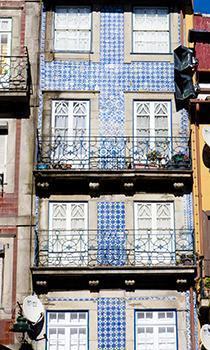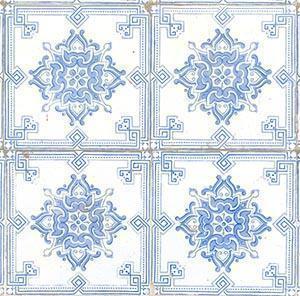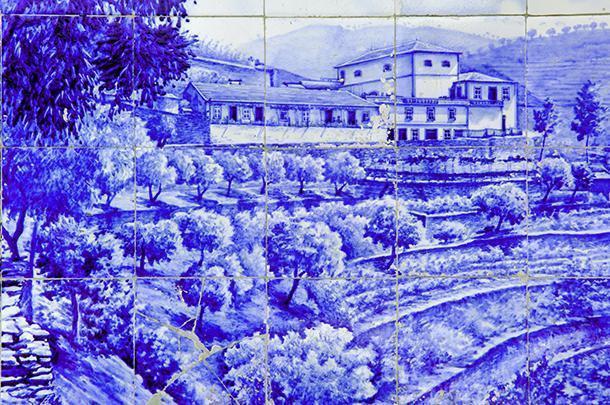Azulejos: Portuguese tiles
Post from EditorialsThe azulejos are very common in the typical Portuguese architecture, earthenware tiles with geometric or figurative typical bright blue.
Origin and history of azulejos
 Walking through a Portuguese town (and especially the streets of Lisbon) is impossible not to notice the beautiful tiles, majolica tiles with geometric or figurative unmistakable bright blue that cover many surfaces both internal and external (including for example the walls of public places, entrance halls and subway stations, fountains, patios, floors, bar counters, altars and churches of the Baroque style), or even the facades of buildings.
Walking through a Portuguese town (and especially the streets of Lisbon) is impossible not to notice the beautiful tiles, majolica tiles with geometric or figurative unmistakable bright blue that cover many surfaces both internal and external (including for example the walls of public places, entrance halls and subway stations, fountains, patios, floors, bar counters, altars and churches of the Baroque style), or even the facades of buildings.
Their use is very old: contrary to popular belief, the word azulejos does not come from the Portuguese azul (ie blue) but from the Arabic az-zuleiq, which literally means polished stone: the azulejos - or rather their direct ancestors, known with the name of alicatado and made from thin sheets of glazed clay and colored which the floors where covered with and (more rarely) even the walls - would in fact be born in the Middle Ages as an imitation of the poorest Arab mosaics in glass paste, visible for example in famous Alhambra in Granada.
Subsequently, in addition to the twist motifs geometric patterns typical of Arab art, since the Renaissance, and especially since the Baroque - when the azulejo began to spread in the interior decoration of churches and chapels - we witnessed a remarkable evolution, which led to the introduction of large figurative panels with sacred images or profane, still widespread.
Even during the liberty period the azulejos knew a great fortune, thanks especially to the floral decorations on the facades of buildings (consisting mainly in pretty ornamental friezes) and shop signs, usually bearing the name of the store, the tools of the trade and some allegorical scene in character with the work carried out: on the panels on the outside of the historic Tabacaria Monaco in Lisbon appear some animals (including a frog and a pelican) offering to eachother and smoking showy cigars.
The tradition of azulejos today is as lively as ever in Portugal, because the production has never stopped: in addition to the tiles produced as souvernir for tourists and figurative panels performed also on order for many amateurs, the majolica tiles are in fact very spread in the elements of street furniture, including precisely signs, plaques with the names of the streets, the small devotional shrines, fountains and often in public and private buildings.
Processing azulejo

The processing of azulejos, often performed in a traditional way at specialized laboratories and small factories follows very precise procedures.
The oldest of these, called a corda seca, planned to give to the tiles their square shape with a mold, similar to what happened to the common brick. Next, we went to the realization of the decoration using a proper mask similar to the boxes used in the operation of dusting of frescoes.
The colors - the oldest azulejos were indeed colorful - were made of special glazes in the colors cobalt blue, green cover, honey brown, dark brown, red and white: to prevent that the glazes are mixed during cooking, the contours of the decorative motifs were passed with a brush with a black color mixed with a fatty substance (such as linseed oil).
Subsequently, to avoid the long (and therefore costly) tracking operation of the pattern on each piece, they began to use small matrices of wood to print the drawing directly on the fresh clay: these tiles are easily recognizable because of the typical contours in light undercut (not colored deep enough to separate the glazes). The technique is known as dry rope with cracks. However, many pieces were often defective and therefore unusable: they figured out to then replace the contours undercut with other relief, adopting carved mold.
In the sixteenth century, the production methods are completely renewed: from Italy was in fact introduced the technique of working of the majolica, known since the twelfth century. It is since that period that the figurative panels composed of many combined tiles started to spread out, inspired by the new Renaissance painting and made possible by the processing technique that allows the execution of very minute nuances and details, including for example the faces or leaves of the trees. However, the new technique was very expensive, because the painting of complex figurative scenes required specialized, capable painters.
Azulejo and architecture

As already mentioned above, the azulejo occur in various types:
- Tiles with geometric or floral repeated motifs on each piece, generally intended for covering walls and floors: four combined tiles usually form the complete ornamental motif;
- Patterned modular pieces, put in sequence make ornamental friezes, very common for example in art nouveau buildings;
- Panels with figurative scenes, even very complex (see for example the photo at the beginning of this paragraph) made with several combined tiles, similar to what happens in a puzzle: the most common reasons are the still-lifes paintings, landscapes and scenes of the everyday life (fishing, country life, the city ...), religious or historical theme, patriotic and celebratory. Finally, there are signs and advertising signs.
In our houses, we can use the azulejo in many different ways:
- To report the number or the name of the owners;
- To make small sacred images on the facade: it is a widespread use still in the countryside and especially in the South;
- To cover walls and floors, both with complex figurative panels, both with azulejos with serial reasons: in this case, you get very beautiful and special effects randomly placing tiles with different decorations. In addition, the color blue is particularly suitable for the bathroom, the kitchen or at the veranda of houses in places by the sea.
However, not to make use of imitations we must turn to brands, such as the company Camilù from Torrimpietra (Roma), which imports from Portugal the original tiles, or to the company Savoia Italy, which in its catalog offers a collection inspired by the azulejos.
80273 REGISTERED USERS










